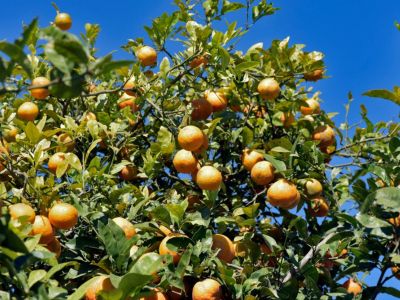Cold Climate Citrus Trees
Citrons, lemons, and limes are the least cold hardy of the citrus trees and are killed or damaged when temps are in the high 20s. Sweet oranges and grapefruit are slightly more tolerant and can withstand temperatures in the mid 20’s before succumbing. Citrus trees that are cold tolerant down into the low 20s, such as tangerines and mandarins, are the most optimistic choice for planting cold climate citrus trees. When growing citrus trees in cold climates, the degree to which damage may occur is related not only to the temperature but a number of other factors. The duration of a freeze, how well the plant has hardened prior to a freeze, the age of the tree, and overall health will all affect if and how much a citrus is affected by a drop in temperature.
Varieties of Cold Climate Citrus Trees
A list of some citrus trees that are the most cold tolerant is as follows:
Calamondin (16 degrees F./-8 degrees C.) Chinotto Orange (16 degrees F./-8 degrees C.) Changsha Tangerine (8 degrees F./-13 degrees C.) Meiwa Kumquat (16 degrees F./-8 degrees C.) Nagami Kumquat (16 degrees F./-8 degrees C.) Nippon Orangequat (15 degrees F./-9 degrees C.) Ichang Lemon (10 degrees F./-12 degrees C.) Tiwanica Lemon (10 degrees F./-12 degrees C.) Rangpur Lime (15 degrees F./-9 degrees C.) Red Lime (10 degrees F./-12 degrees C.) Yuzu Lemon (12 degrees F./-11 degrees C.)
Choosing a trifoliate rootstock will ensure you are getting the most cold hardy variety of citrus. The smaller sweet citruses, such as Satsuma and tangerine, seem to have the most cold tolerance.
Care of Hardy Citrus Trees
Once you have selected your cold hardy citrus tree, there are several keys to ensuring its survival. Select a sunny location that is sheltered from the cold northern winds with well-draining soil. If you are not container planting the citrus, plant it in bare, non-turf ground. Turf around the base of the tree can significantly lower the temperature, as can situating the tree at the bottom of a hill or slope. Place the root ball of the citrus 2 inches (5 cm.) higher than the surrounding soil to promote drainage. Do not mulch around the tree, as this will retain moisture as well as encourage diseases such as root rot.
How to Protect Growing Citrus Trees in Cold Climates
It is crucial that you take protective measures when the threat of a cold snap is imminent. Be sure to cover the entire plant, taking care not to touch the foliage. A double-layered covering of a blanket over layered with plastic is ideal. Bring the covering all the way to the base of the tree and hold it down with bricks or other heavy weights. Make sure you remove the cover when temps rise above freezing. Do not fertilize the citrus after August since this will encourage new growth, which is sensitive to cold temps. Once your citrus tree is established, it will be better able to withstand and recover from freezing temperatures.
